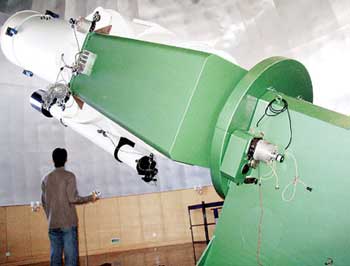| Home / China / Photos / National | Tools: Save | Print | E-mail | Most Read |
| China's Largest Schmidt Telescope Built |
| Adjust font size: |
China has built a new Schmidt telescope, the largest of its kind in China, to keep track of near-earth objects (NEO) that could threaten Planet Earth.
The telescope, measuring one meter in diameter, has been tested in a branch observatory belonging to Mount Zijin Observatory under the Chinese Academy of Sciences, in east China's Jiangsu Province. Near-earth objects are comets and asteroids that have been nudged by the gravitational attraction of nearby planets into orbits that allow them to enter the earth's neighborhood. Equipped with sensitive CCD (Charge-Coupled Device) detectors, the telescope will help scientists document all NEOs, including unknown ones, for further study, and enable scientists to know in advance whether a NEO poses a threat to the earth, said Yang Jiexing, a researcher with the observatory. "It is quite likely that some asteroids and comets hit the earth in the past, and it might happen again in the future," said Yang. "We built this detector to know in advance of any approaching danger, and be able to figure out how to deal with it," he said. Scientists will take pictures of the NEOs and establish an archive. Uncertain evidence suggests that a meteoroid 45-90 meters in diameter caused an aerial explosion that flattened about 2,000 square kilometers of pine forest near the Stony Tunguska River in central Siberia in 1908, with the energy estimated to be equivalent to that of about 15 megatons of TNT. So far, more than 800 near-earth asteroids have been discovered by scientists, including nearly 100 with a diameter over over 1,000 meters.
(China.org.cn, Xinhua News Agency November 22, 2006) |
| Tools: Save | Print | E-mail | Most Read |
 |
| Related Stories |


